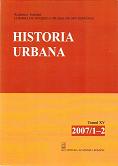Banca Naţională (Săsească) din Braşov – o clădire Jugendstil
The National Bank of the Saxons from Braşov – a Jugendstil Building
Author(s): Anca Maria ZamfirSubject(s): History
Published by: Editura Academiei Române
Keywords: Braşov; National Saxon Bank; Jugendstil Building; architect Albert Schuller;
Summary/Abstract: At the end of the XIX century and the beginning of the XX century, Braşov was a prosperous city, with an intense industrial, commercial and social life, in full modernization. In the second half of the XIX century, in the city already existed German, Romanian and Hungarian banks that functioned in old buildings built for apartments or shops. This study discusses the building built in 1905 – 1908 for the National Saxon Bank. Its importance consists in its European modernity as regarding the style and the architectonical program. It was the first building in the city that was built with the precise purpose of being a bank, with an architectural program conceived according to the modern principles of the 1900 architecture, adapting the building to its function, responding to the three necessities of the time: functional – comfortable – aesthetic. The building has been designed in 1905 by the local architect Albert Schuller (1877 – 1948), who had just returned in 1903 from his studies in München., whence he brought in Braşov the principles of Jugendstil, having a major contribution at the architectural image of the city in the first half of the XX century. He designed a two-storey corner house, proposing a modern architectural program that had to resolve the two functions of the building: bank and apartments. Each of these functions needed its position and its space arrangement. The modernity of the building consists in its conception according to the two essential principles of 1900 architecture that will lay the foundations of the modern architecture: the principle of the utility and the principle of the organic function.
Journal: Historia Urbana
- Issue Year: XV/2007
- Issue No: 1+2
- Page Range: 157-175
- Page Count: 19
- Language: Romanian
- Content File-PDF

